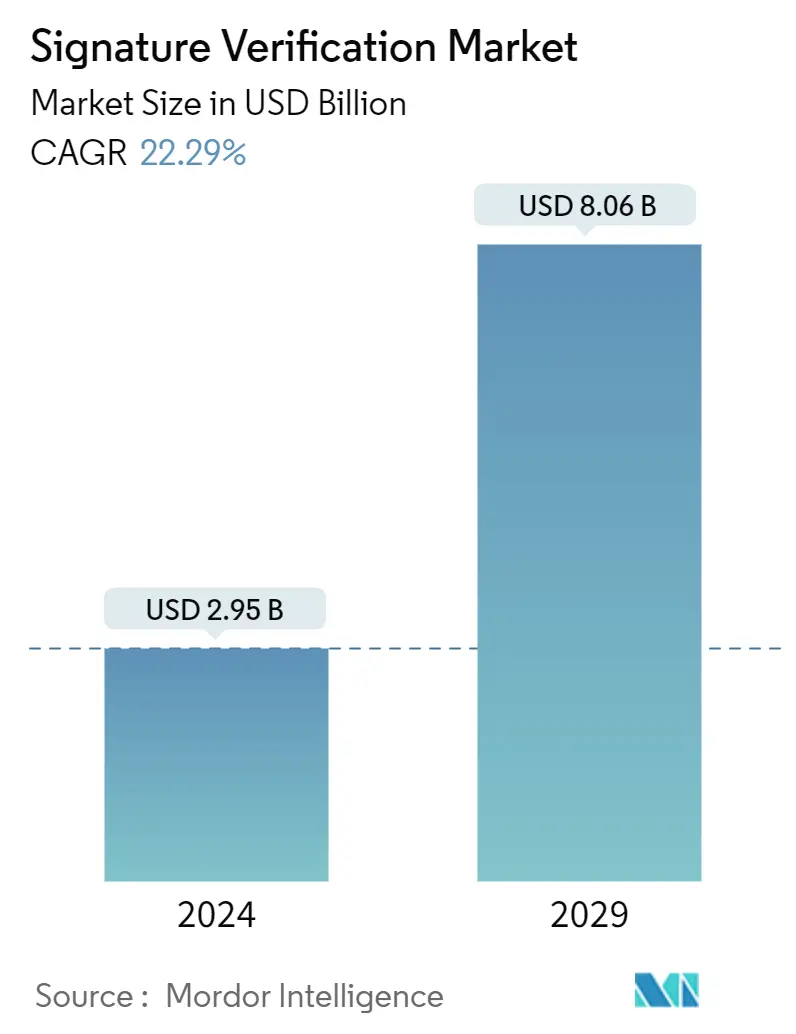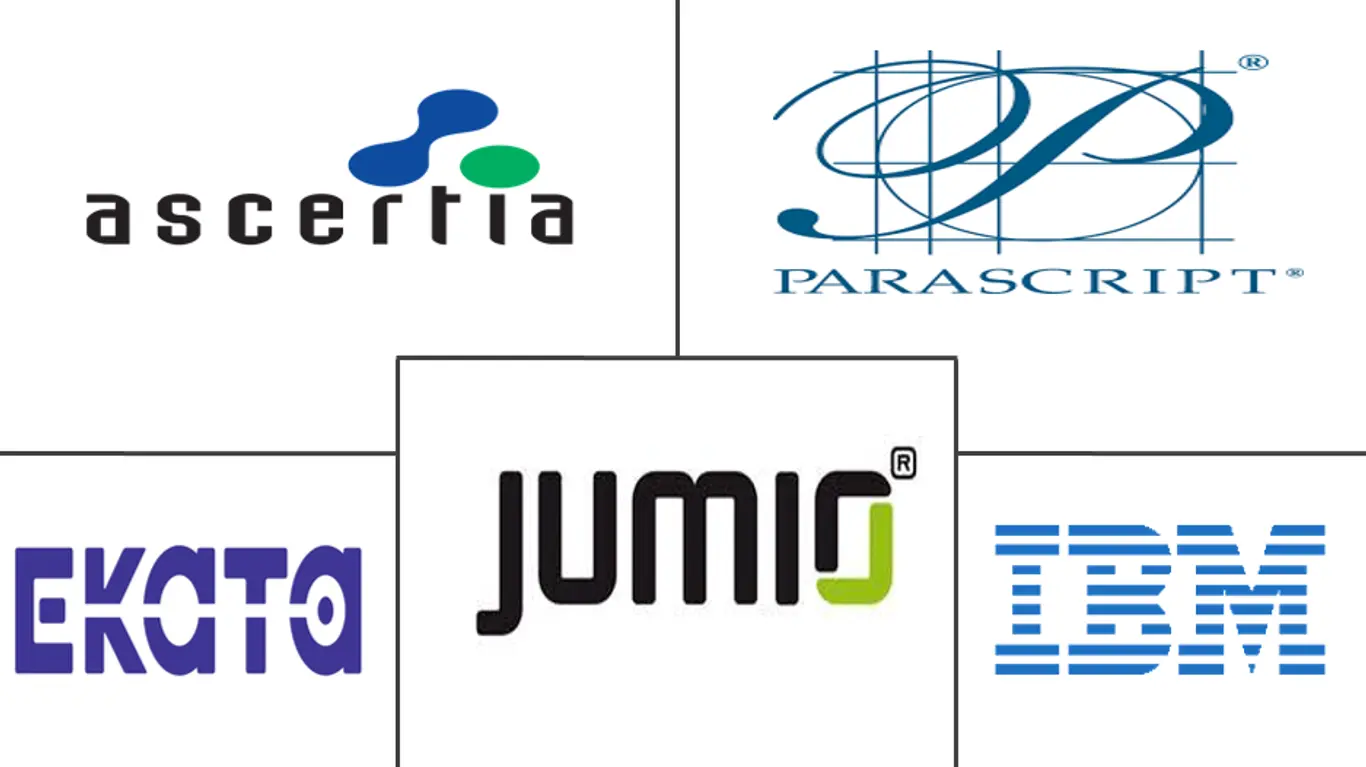Market Size of Signature Verification Industry

| Study Period | 2019-2029 |
| Market Size (2024) | USD 2.95 Billion |
| Market Size (2029) | USD 8.06 Billion |
| CAGR (2024 - 2029) | 22.29 % |
| Fastest Growing Market | Asia Pacific |
| Largest Market | North America |
Major Players
*Disclaimer: Major Players sorted in no particular order |
Signature Verification Market Analysis
The Signature Verification Market size is estimated at USD 2.95 billion in 2024, and is expected to reach USD 8.06 billion by 2029, growing at a CAGR of 22.29% during the forecast period (2024-2029).
In order to authorise transactions and documents, signatures are especially applied by authorities like governments, businesses and financial organisations for verification purposes. They provide a method of authentication based on the dynamic features of an individual's handwriting signature and its characteristics to verify their identity.
- Automatic signature verification is an attractive field of research from both scientific and commercial points of view. In recent years, in line with continuous growth of the internet and increasing security requirements for development of an e-society, automatic signature verification is being considered since it uses a customary personal authentication method accepted at both legal and social levels.
- In order to protect banks and customers from fraudulent checks, the primary purpose of automated signature verification is to ensure that they are signed correctly. A number of banks automatically process checks at a specific value, putting them at risk of accepting forged checks. Then, they manually perform spot checks and look at checks over particular amounts, a process that ultimately wastes both time and money.
- In addition, the BFSI industry's main concern is end to end encryption and security. In order to provide a secure and accurate authentication system to address these concerns, the BFSI sector is increasingly investing in the market for signature verification.
- Handwritten signatures often use scanned signatures for verification, while online and dynamic systems majorly rely upon the signals captured from pen movement on a tablet or touchscreen. This provides more information compared to static images, such as pen speed and pressure.
- Also, the COVID-19 pandemic has developed a need for digital signatures in different industries. Recently, the Centers for Medicare & Medicaid Services authorized the use of electronic signatures under commonly accepted Washington State procedures.
Signature Verification Industry Segmentation
The signature verification market refers to the market for software and hardware technologies used to authenticate and verify handwritten signatures, both in-person and electronic signatures.
The signature verification market is segmented by type of solution (hardware and software), end-user industry (financial services, government, healthcare, transportation, and logistics), and geography (North America (united states, canada), Europe, Asia-Pacific, and the Rest of the World).
The market sizes and forecasts are provided in terms of value (USD) for all the above segments
| By Type of Solution | |
| Hardware | |
| Software |
| By End-user Industry | |
| Financial Services | |
| Government | |
| Healthcare | |
| Transport and Logistics | |
| Other End-user Industries |
| By Geography | ||||
| ||||
| Europe | ||||
| Asia Pacific | ||||
| Rest of the World |
Signature Verification Market Size Summary
The signature verification market is poised for significant growth, driven by the increasing need for secure authentication methods across various sectors, particularly in the financial services industry. This market is characterized by the use of dynamic features of handwriting signatures to verify identities, which is crucial for authorizing transactions and documents. The rise of digital transformation and the surge in online transactions have amplified the demand for signature verification solutions, especially in regions like Asia-Pacific, where cashless payments are on the rise. The COVID-19 pandemic has further accelerated the adoption of digital signatures, as industries seek to enhance security and streamline processes. Automated signature verification systems, which capture detailed pen movements on digital devices, offer a more comprehensive approach compared to traditional static image methods, addressing the growing concerns of fraud and security breaches.
The market landscape is semi-consolidated, with established players dominating and new entrants facing challenges in gaining a foothold. Companies like Biometric Signature ID, CERTIFY Global Inc., and Ascertia Ltd. hold significant market shares, while recent collaborations and technological advancements continue to shape the industry. Innovations such as Jumio's 360° Fraud Analytics and Veriff's partnership with Taktikal highlight the ongoing efforts to enhance identity verification and fraud prevention capabilities. Regulatory frameworks in countries like China and India support the legal validity of electronic signatures, further bolstering market growth. As the demand for secure and efficient signature verification solutions rises, the market is expected to expand, offering opportunities for both established and emerging players to innovate and capture market share.
Signature Verification Market Size - Table of Contents
-
1. MARKET INSIGHTS
-
1.1 Market Overview
-
1.2 Industry Attractiveness - Porter's Five Forces Analysis
-
1.2.1 Bargaining Power of Suppliers
-
1.2.2 Bargaining Power of Buyers
-
1.2.3 Threat of New Entrants
-
1.2.4 Threat of Substitute Products
-
1.2.5 Intensity of Competitive Rivalry
-
-
1.3 Impact of COVID-19 on the Market
-
-
2. MARKET SEGMENTATION
-
2.1 By Type of Solution
-
2.1.1 Hardware
-
2.1.2 Software
-
-
2.2 By End-user Industry
-
2.2.1 Financial Services
-
2.2.2 Government
-
2.2.3 Healthcare
-
2.2.4 Transport and Logistics
-
2.2.5 Other End-user Industries
-
-
2.3 By Geography
-
2.3.1 North America
-
2.3.1.1 United States
-
2.3.1.2 Canada
-
-
2.3.2 Europe
-
2.3.3 Asia Pacific
-
2.3.4 Rest of the World
-
-
Signature Verification Market Size FAQs
How big is the Signature Verification Market?
The Signature Verification Market size is expected to reach USD 2.95 billion in 2024 and grow at a CAGR of 22.29% to reach USD 8.06 billion by 2029.
What is the current Signature Verification Market size?
In 2024, the Signature Verification Market size is expected to reach USD 2.95 billion.

